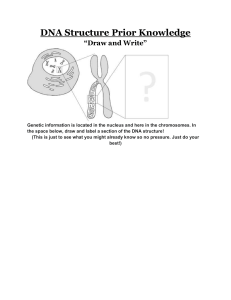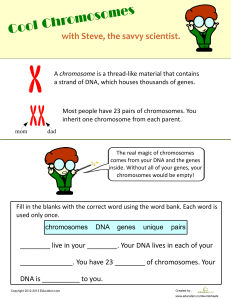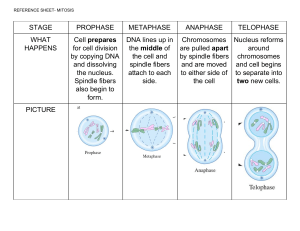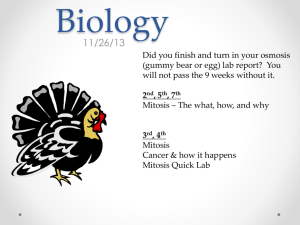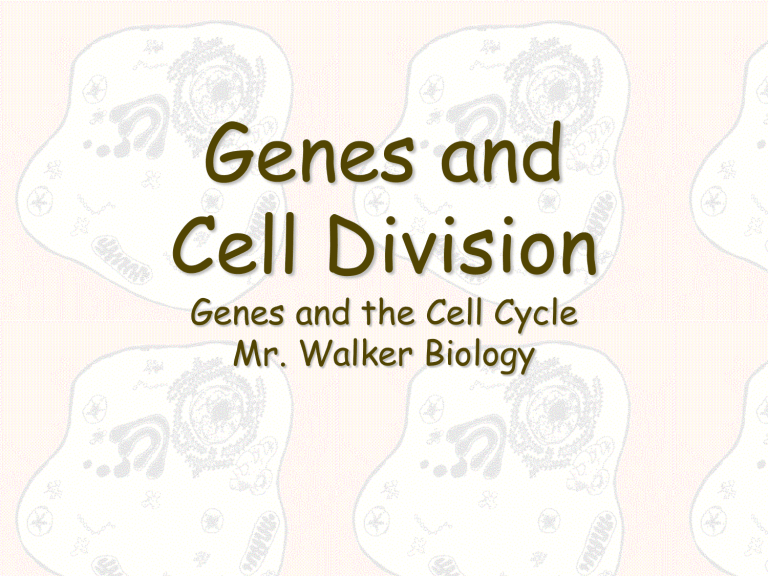
Genes and Cell Division Genes and the Cell Cycle Mr. Walker Biology Obj 1: Function of Genes • Genes are composed of DNA which is the instructions on how to build a protein. • Regions of DNA which codes for proteins are called Exons. • Regions of DNA which do not code for proteins are called Introns. • Genes are used by organisms to build proteins like enzymes, antibodies, and hormones etc. Obj 2: Composition of Chromosomes • • Eukaryote cells divide a complicated system called Mitosis This is because: 1. They have a nucleus which must be broken up and then reformed 2. They have their DNA “packaged” in the form of Chromosomes 3. Chromosomes are composed of Chromatin -Made of DNA Strands & Proteins 4. Also contain Nucleosomes consisting of Histones – Proteins. 5. DNA wrapped around the DNA/Protein complex is Chromatin 6. They usually have more than 1 chromosome (Humans have 23 pairs) 7. They have numerous organelles to equally share • Different levels of DNA condensation. (1) Single DNA strand. (2) Chromatin strand (DNA with histones). (3) Chromatin during interphase with centromere. (4) Condensed chromatin during prophase. (Two copies of the DNA molecule are now present) (5) Chromosome during metaphase. Chromatin / Chromosomes The Cell Cycle •Most of the cell's life is spent doing its regular function. •Cells divide along a rough time frame called its Cell Cycle. •The Cell cycle consists of the following steps: •G1 (Gap 1) Phase - Cell performs its normal function (cells which do not divide stay in this stage for their entire life span) •S (Synthesis) Phase - Here the cell actively duplicates its DNA in preparation for division •G2 (Gap 2) Phase - Amount of cytoplasm (including organelles) increases in preparation for division. •Mitosis - Actual division occurs Chromosome vs Sister Chromatid Interphase • Cell Replicates its DNA/Chromosomes in preparation of upcoming division Animal Cell Plant cell Prophase 1.Chromosomes Shorten and become visible. 2. Centrioles move to opposite sides of the cell 3. Nuclear envelope disappears 4. Spindle Fibers both together are known as the Spindle Apparatus begin to form Animal Cell Plant Cell Metaphase • Chromosomes line up along center of cell called the Metaphase Plate • Chromosomes attach to spindle fibers • Spindle fibers are now clearly visible Animal Cell Plant Cell Anaphase • Centromeres break up separating chromosome copies • Chromosomes are pulled apart to opposite sides of cell • Spindle fibers begin to break down Animal Cell Plant Cell Telophase (cytokinesis) • Nuclear envelope forms around both sets of chromosomes • DNA uncoils • Spindle & Astral fibers completely disappear – Cytokinesis happens with most (but not all) cells – Cytoplasm & organelles move (mostly equally) to either side of the cell.Cell Membrane “pinches” to form 2 separate cells Animal Cell Plant Cell Animal Cytokineisis • Cytokinesis differs significantly between Animal & Plant cells. • With animals, the membranes pinch together to form a Cleavage Furrow, which eventually fuses to form two daughter cells Plant Cytokinesis • With Plants, a cell wall must be formed between the 2 daughter cells. • Vesicles containing Cellulose form and fuse between the two daughter cells (called a cell plate), eventually forming a complete cell wall. Overview of Mitosis
